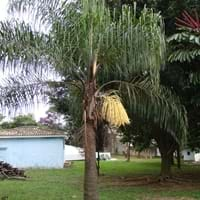Life Span
Perennial
Annual
Type
Perennial
Palm or Cycad
Origin
Eastern Europe
South America, Argentina, Brazil
Types
Not Available
Not Available
Habitat
Terrestrial
Forest edges
USDA Hardiness Zone
4-9
7-15
Sunset Zone
1a, 1b, 2a, 2b, 3a, 3b, 4, 5, 6, 7, 8, 9, 10, 11, 12, 13, 14, 15, 16, 17, 18, 19, 20, 21, 22, 23, 24
H1, H2, 12, 13, 15, 16, 17, 19, 20, 21, 22, 23
Habit
Clump-Forming
Upright/Erect
Flower Color
Yellow, Lavender, Blue Violet
White, Ivory
Flower Color Modifier
Bicolor
Bicolor
Fruit Color
Not Available
Orange
Leaf Color in Spring
Green, Sea Green
Dark Green
Leaf Color in Summer
Green, Sea Green
Dark Green
Leaf Color in Fall
Green, Sea Green
Dark Green
Leaf Color in Winter
Light Green
Dark Green
Leaf Shape
Lanceolate
Long Linear
Plant Season
Spring, Summer
Spring, Summer, Fall, Winter
Sunlight
Full Sun, Partial Sun
Full Sun, Partial Sun
Growth Rate
Medium
Very Fast
Type of Soil
Loam, Sand
Loam, Sand
The pH of Soil
Neutral
Acidic, Neutral
Soil Drainage
Well drained
Well drained
Bloom Time
Spring, Late Spring, Early Summer
Summer
Tolerances
Drought
Wet Site
Where to Plant?
Ground
Ground
How to Plant?
By dividing rhizomes, tubers, Seedlings
Seedlings, Transplanting
Plant Maintenance
Medium
Medium
Watering Requirements
Average Water Needs, Do Not over Water
Does not require lot of watering, Use and maintain water-efficient soaker hoses, Use Mulches to help prevent water loss during hot and windy weather, Water in morning to avoid prompting diseases, Water twice a day in the initial period
In Summer
Lots of watering
Lots of watering
In Spring
Moderate
Moderate
In Winter
Average Water
Average Water
Soil pH
Neutral
Acidic, Neutral
Soil Type
Loam, Sand
Loam, Sand
Soil Drainage Capacity
Well drained
Well drained
Sun Exposure
Full Sun, Partial Sun
Full Sun, Partial Sun
Pruning
Remove damaged leaves, Remove dead branches, Remove dead leaves
Cut or pinch the stems, Prune for shortening long shoots, Remove dead or diseased plant parts
Fertilizers
All-Purpose Liquid Fertilizer
All-Purpose Liquid Fertilizer, Fertilize before watering, fertilize in growing season
Pests and Diseases
Red blotch
Fungal Diseases
Plant Tolerance
Drought
Wet Site
Flower Petal Number
Single
Single
Foliage Texture
Coarse
Bold
Foliage Sheen
Matte
Glossy
Attracts
Hummingbirds
Birds
Allergy
Skin irritation
Asthma
Aesthetic Uses
Showy Purposes
Not Used For Aesthetic Purpose
Beauty Benefits
Not Available
Not Available
Environmental Uses
Air purification
Air purification
Medicinal Uses
No Medicinal Use
No Medicinal Use
Part of Plant Used
Not Available
Fruits, Leaves
Other Uses
Used as Ornamental plant
Cattle Fodder
Used As Indoor Plant
No
No
Used As Outdoor Plant
Yes
Yes
Garden Design
Alpine, Edging, Mixed Border, Rock Garden, Wall
Feature Plant, Street Trees, Tropical
Botanical Name
IRIS pumila
SYAGRUS romanzoffiana
Common Name
Dwarf Iris
Queen Palm
In Hindi
Dwarf Iris
queen palm
In German
Zwergiris
Königin palme
In French
Dwarf Iris
reine palme
In Spanish
Enano Iris
palma reina
In Greek
νάνος Ίρις
βασίλισσα φοίνικες
In Portuguese
Dwarf Iris
palm rainha
In Polish
Dwarf Iris
królowa palmowy
In Latin
Iris Dwarf
regina palmarum
Phylum
Magnoliophyta
Tracheophyta
Class
Liliopsida
Liliopsida
Family
Iridaceae
Arecaceae
Clade
Angiosperms, Monocots
Angiosperms, Commelinids, Monocots
Subfamily
Iridoideae
Arecoideae
Number of Species
Not Available
Properties of Dwarf Iris and Queen Palm
Wondering what are the properties of Dwarf Iris and Queen Palm? We provide you with everything About Dwarf Iris and Queen Palm. Dwarf Iris doesn't have thorns and Queen Palm doesn't have thorns. Also Dwarf Iris does not have fragrant flowers. Dwarf Iris has allergic reactions like Skin irritation and Queen Palm has allergic reactions like Skin irritation. Compare all the properties and characteristics of these two plants. Find out which of these plant can be used as indoor plant. If you are interested to decorate your house and garden, find out aesthetic uses, compare them and select the plant which will beautify your surrounding. Along with beautification, try comparing medicinal and edible uses of Dwarf Iris and Queen Palm and you can choose the plant having best and most benefits.
Season and Care of Dwarf Iris and Queen Palm
Season and care of Dwarf Iris and Queen Palm is important to know. While considering everything about Dwarf Iris and Queen Palm Care, growing season is an essential factor. Dwarf Iris season is Spring and Summer and Queen Palm season is Spring and Summer. The type of soil for Dwarf Iris is Loam, Sand and for Queen Palm is Loam, Sand while the PH of soil for Dwarf Iris is Neutral and for Queen Palm is Acidic, Neutral.
Dwarf Iris and Queen Palm Physical Information
Dwarf Iris and Queen Palm physical information is very important for comparison. Dwarf Iris height is 10.20 cm and width 15.20 cm whereas Queen Palm height is 213.00 cm and width 610.00 cm. The color specification of Dwarf Iris and Queen Palm are as follows:
Dwarf Iris flower color: Yellow, Lavender and Blue Violet
Dwarf Iris leaf color: Green and Sea Green
Queen Palm flower color: White and Ivory
- Queen Palm leaf color: Dark Green
Care of Dwarf Iris and Queen Palm
Care of Dwarf Iris and Queen Palm include pruning, fertilizers, watering etc. Dwarf Iris pruning is done Remove damaged leaves, Remove dead branches and Remove dead leaves and Queen Palm pruning is done Cut or pinch the stems, Prune for shortening long shoots and Remove dead or diseased plant parts. In summer Dwarf Iris needs Lots of watering and in winter, it needs Average Water. Whereas, in summer Queen Palm needs Lots of watering and in winter, it needs Average Water.





